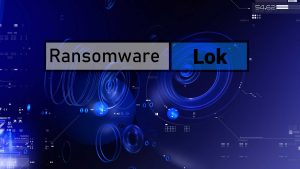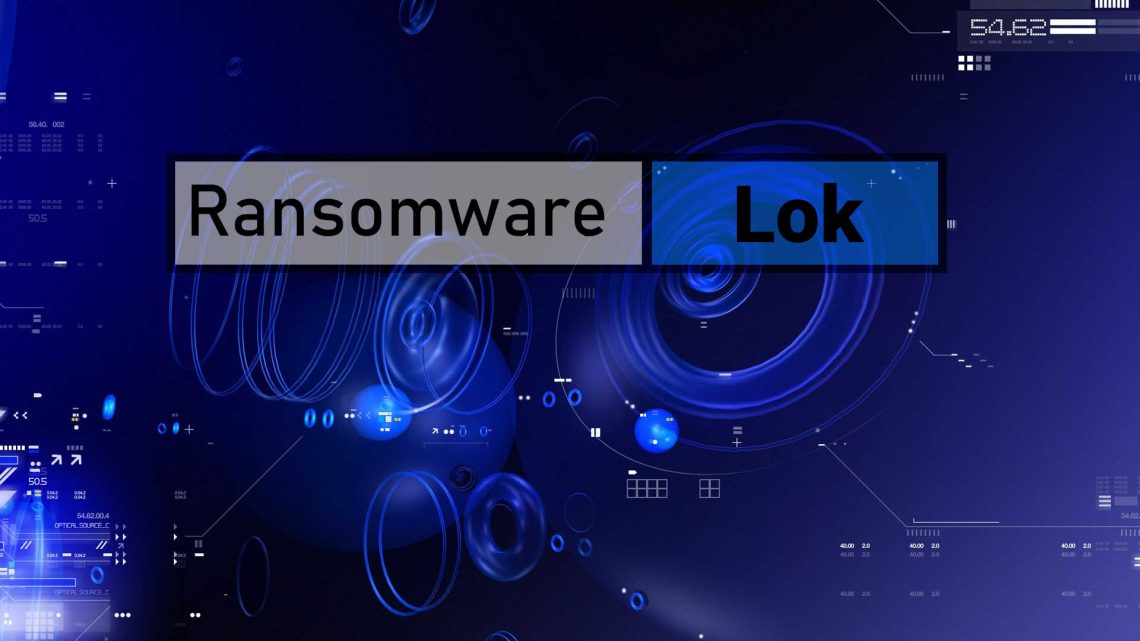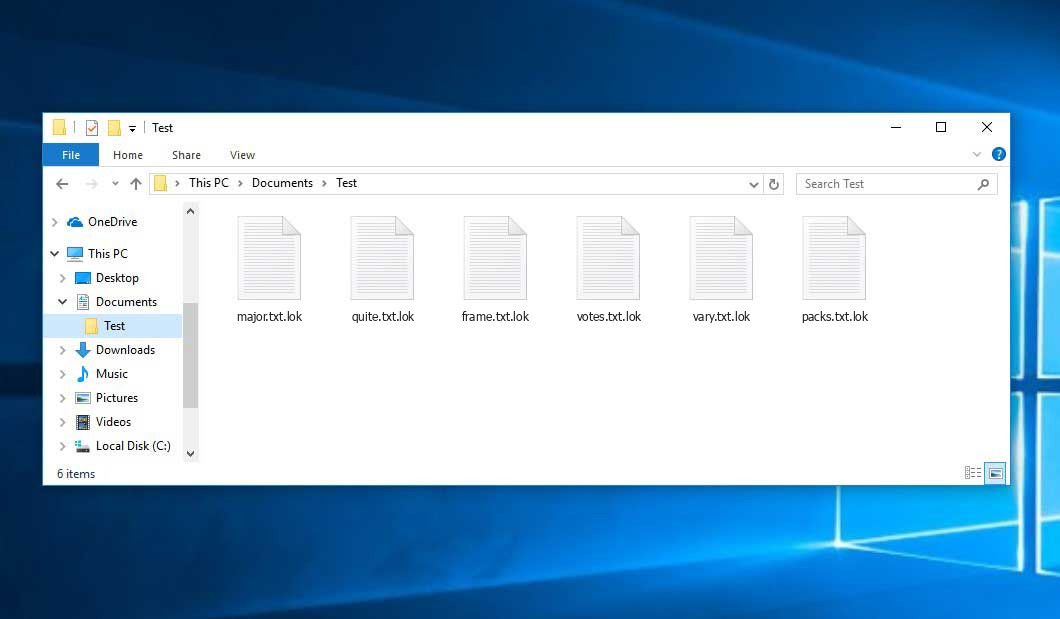The Lok virus belongs to the ransomware type of infection. A harmful program of this type encrypts all user’s data on the computer (images, documents, excel sheets, music, videos, etc) and adds its specific extension to every file, creating the Decryption-Guide.txt files in each directory which contains the encrypted files.
Lok virus: what is known so far?
☝️ A strictly accurate designation for the Lok is “a ransomware infection”.
Lok will append its extra .lok extension to every file’s title. For example, a file named “photo.jpg” will be turned into “photo.jpg.lok”. Just like the Excel file named “table.xlsx” will become “table.xlsx.lok”, and so forth.
In each directory that contains the encoded files, a Decryption-Guide.txt file will appear. It is a ransom money note. Therein you can find information about the ways of paying the ransom and some other remarks. The ransom note most probably contains instructions on how to purchase the decryption tool from the tamperers. You can get this decrypting software after contacting [email protected] by email. That is how they do it.
Lok outline:
| Name | Lok Virus |
| Extension | .lok |
| Ransomware note | Decryption-Guide.txt |
| Contact | [email protected] |
| Detection | Win64:Malware-gen, Ransom.FileCryptor.Python.Generic, Win32/Filecoder.Conti.V |
| Symptoms | Your files (photos, videos, documents) have a .lok extension and you can’t open them. |
| Fix Tool | See If Your System Has Been Affected by Lok virus |
The Decryption-Guide.txt file accompanying the Lok ransomware states the following:
Your Files Are Has Been Locked Your Files Has Been Encrypted with cryptography Algorithm If You Need Your Files And They are Important to You, Dont be shy Send Me an Email Send Test File + The Key File on Your System (File Exist in C:/ProgramData example : RSAKEY-SE-24r6t523 pr RSAKEY.KEY) to Make Sure Your Files Can be Restored Make an Agreement on Price with me and Pay Get Decryption Tool + RSA Key AND Instruction For Decryption Process Attention: 1- Do Not Rename or Modify The Files (You May loose That file) 2- Do Not Try To Use 3rd Party Apps or Recovery Tools ( if You want to do that make an copy from Files and try on them and Waste Your time ) 3-Do not Reinstall Operation System(Windows) You may loose the key File and Loose Your Files 4-Do Not Always Trust to Middle mans and negotiators (some of them are good but some of them agree on 4000usd for example and Asked 10000usd From Client) this Was happened Your Case ID :- OUR Email :[email protected]
In the picture below, you can see what a directory with files encrypted by the Lok looks like. Each filename has the “.lok” extension added to it.
How did my machine catch Lok ransomware?
There are plenty of possible ways of ransomware infiltration.
Nowadays, there are three most popular ways for criminals to have the Lok virus settled in your digital environment. These are email spam, Trojan infiltration and peer networks.
If you open your mailbox and see emails that look like familiar notifications from utility services providers, postal agencies like FedEx, web-access providers, and whatnot, but whose addresser is strange to you, beware of opening those emails. They are most likely to have a viral item attached to them. So it is even riskier to open any attachments that come with emails like these.
Another option for ransom hunters is a Trojan horse model1. A Trojan is an object that infiltrates into your PC pretending to be something else. For instance, you download an installer for some program you want or an update for some software. However, what is unpacked turns out to be a harmful agent that corrupts your data. As the installation file can have any title and any icon, you have to make sure that you can trust the resource of the things you’re downloading. The optimal thing is to trust the software companies’ official websites.
As for the peer file transfer protocols like torrents or eMule, the threat is that they are even more trust-based than the rest of the Internet. You can never guess what you download until you get it. Our suggestion is that you use trustworthy websites. Also, it is reasonable to scan the folder containing the downloaded objects with the anti-malware utility as soon as the downloading is finished.
How do I get rid of the Lok virus?
It is important to inform you that besides encrypting your files, the Lok virus will most likely install the Azorult Spyware on your machine to seize your credentials to different accounts (including cryptocurrency wallets). That spyware2 can derive your logins and passwords from your browser’s auto-filling cardfile.
Sometimes racketeers would decrypt some of your files to prove that they indeed have the decryption program. As Lok virus is a relatively recent ransomware, security software engineers have not yet found a method to undo its work. However, the anti-ransomware instruments are constantly upgraded, so the solution may soon be available.
Understandably, if the tamperers do the job of encrypting someone’s critical files, the hopeless person will probably comply with their demands. Despite that, paying to criminals gives no guarantee that you’re getting your blocked information back. It is still risky. After obtaining the money, the racketeers may deliver a wrong decryption key to the victim. There were reports about racketeers simply vanishing after getting the ransom without even bothering to reply.
The optimal countermeasure to ransomware is to have aan OS restore point or the copies of your critical files in the cloud disk or at least on an external storage. Surely, that might be insufficient. Your most crucial thing could be that file you were working on when it all went down. Nevertheless, it is something. It is also reasonable to scan your drives with the antivirus program after the system is rolled back.
There are other ransomware products, besides Lok, that work similarly. Examples of those are Xcmb, Dehd, Hudf, and some others. The two main differences between them and the Lok are the ransom amount and the encoding method. The rest is almost identical: files become encrypted, their extensions altered, ransom notes appear in every directory containing encrypted files.
Some lucky people were able to decrypt the arrested files with the help of the free software provided by anti-ransomware specialists. Sometimes the racketeers mistakenly send the decryption key to the victims in the ransom readme. Such an extraordinary fail allows the user to restore the files. But obviously, one should never rely on such a chance. Remember, ransomware is a criminals’ instrument to pull the money out of their victims.
How to avoid ransomware injection?
Lok ransomware has no endless power, so as any similar malware.
You can protect yourself from its attack in several easy steps:
- Ignore any emails from unknown senders with unknown addresses, or with content that has likely no connection to something you are waiting for (can you win in a money prize draw without even taking part in it?). If the email subject is more or less something you are waiting for, check all elements of the suspicious email with caution. A hoax letter will surely contain a mistake.
- Never use cracked or unknown programs. Trojan viruses are often distributed as an element of cracked software, most likely under the guise of “patch” preventing the license check. But dubious programs are difficult to distinguish from reliable software, because trojans sometimes have the functionality you need. Try to find information on this software product on the anti-malware message boards, but the best way is not to use such software.
- And finally, to be sure about the safety of the objects you downloaded, check them with GridinSoft Anti-Malware. This software will be a perfect armor for your system.
Reasons why I would recommend GridinSoft3
There is no better way to recognize, remove and prevent ransomware than to use an anti-malware software from GridinSoft4.
Download Removal Tool.
You can download GridinSoft Anti-Malware by clicking the button below:
Run the setup file.
When setup file has finished downloading, double-click on the setup-antimalware-fix.exe file to install GridinSoft Anti-Malware on your computer.

An User Account Control asking you about to allow GridinSoft Anti-Malware to make changes to your device. So, you should click “Yes” to continue with the installation.

Press “Install” button.

Once installed, Anti-Malware will automatically run.

Wait for the Anti-Malware scan to complete.
GridinSoft Anti-Malware will automatically start scanning your system for Lok infections and other malicious programs. This process can take a 20-30 minutes, so I suggest you periodically check on the status of the scan process.

Click on “Clean Now”.
When the scan has finished, you will see the list of infections that GridinSoft Anti-Malware has detected. To remove them click on the “Clean Now” button in right corner.

FAQ
🤔 How can I open “.lok” files?Can I somehow access “.lok” files?
There’s no way to do it, unless the files “.lok” files are decrypted.
🤔 What should I do to make my files accessible as fast as possible?
It’s good if you have fаr-sightedly saved copies of these important files elsewhere. If not, there is still a function of System Restore but it needs a Restore Point to be previously saved. There are other ways to beat ransomware, but they take time.
🤔 You have advised using GridinSoft Anti-Malware to get rid of the Lok virus. Does it mean that all my files, currently encrypted, will be removed too?
No way! Unlike the ransomware program itself, the encrypted files do not jeopardize your system.
GridinSoft Anti-Malware only deals with active viruses. The malware that has infected your system is must be still functional and it scans your system periodically to encode any new files you might create on your computer after the attack. As it has already been said, the Lok malware comes with the company. It installs backdoors and keyloggers that can steal your account credentials and provide criminals with easy access to your computer in the future.
🤔 What actions should I take if the Lok virus has blocked my PC and I can’t get the activation code.
In such a case, you need to prepare a flash memory drive with a pre-installed Trojan Killer. Use Safe Mode to perform the procedure. The point is that the ransomware starts automatically as the system launches and encrypts any new files created or imported into your PC. To block this function – use Safe Mode, which allows only the essential applications to run automatically. Consider reading our manual on booting Windows in Safe Mode.
🤔 What can I do right now?
Many of the encrypted files might still be at your disposal
- If you sent or received your important files by email, you could still download them from your online mailbox.
- You may have shared photographs or videos with your friends or family members. Simply ask them to give those images back to you.
- If you have initially downloaded any of your files from the Web, you can try downloading them again.
- Your messengers, social media pages, and cloud disks might have all those files as well.
- Maybe you still have the needed files on your old PC, a portable device, mobile, flash memory, etc.
USEFUL TIP: You can use data recovery utilities5 to get your lost data back since ransomware encrypts the copies of your files, deleting the original ones. In the video below, you can learn how to use PhotoRec for such a recovery, but be advised: you won’t be able to do it before you remove the virus with an antivirus program.
Also, you can contact the following official fraud and scam sites to report this attack:
- In the United States: On Guard Online;
- In Canada: Canadian Anti-Fraud Centre;
- In the United Kingdom: Action Fraud;
- In Australia: SCAMwatch;
- In New Zealand: Consumer Affairs Scams;
- In France: Agence nationale de la sécurité des systèmes d’information;
- In Germany: Bundesamt für Sicherheit in der Informationstechnik;
- In Ireland: An Garda Síochána;
To report the attack, you can contact local executive boards. For instance, if you live in USA, you can have a talk with FBI Local field office, IC3 or Secret Service.
I need your help to share this article.
It is your turn to help other people. I have written this guide to help people like you. You can use the buttons below to share this on your favorite social media Facebook, Twitter, or Reddit.
Brendan SmithHow to Remove LOK Ransomware & Recover PC

Name: LOK Virus
Description: LOK Virus is a ransomware-type infections. This virus encrypts important personal files (video, photos, documents). The encrypted files can be tracked by a specific .lok extension. So, you can't use them at all.
Operating System: Windows
Application Category: Virus
User Review
( votes)References
- You can read more on Trojans, their use and types in the Trojan-dedicated section of GridinSoft official website.
- You can read more on spyware variants and nature in the respective section of GridinSoft official website.
- GridinSoft Anti-Malware Review from HowToFix site: https://howtofix.guide/gridinsoft-anti-malware/
- More information about GridinSoft products: https://gridinsoft.com/comparison
- Here’s the list of Best Data Recovery Software Of 2023.



